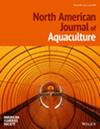棉籽粕作池塘有机肥时对水质、浮游动物密度和黑鲈产量的影响
IF 1.3
4区 农林科学
Q3 FISHERIES
引用次数: 0
摘要
摘要目的将棉籽粕作为有机肥施用于阳光鲈鱼(雌性白鲈Morone chrysops ×雄性条纹鲈M. saxatilis)鱼苗养殖池,促进浮游生物发育。棉籽粕在长期储存和降解后作为肥料的功效尚不清楚。比较了在0.4 - ha鱼池中黑鲈鱼种生产过程中降解棉籽粕和未降解棉籽粕的使用情况。方法在放养鱼苗前13天至放养鱼苗后6天反复施肥,监测水质、浮游动物和41 ~ 48天的鱼苗产量。两种条件下的棉籽粕均可维持足够的浮游植物和浮游动物密度。结果棉籽粕条件对鱼类各项生产指标均无显著影响。降解后的棉籽粕释放氮素的速度更快,这与较高的nh3‐N浓度有关。更高的养分利用率可能以更快的速度刺激初级生产力,导致更高的溶解氧、pH值和浮游动物密度在池塘循环的前半段。施用降解棉籽粕的池塘需要更严格的水质管理,以保持阳光鲈鱼鱼苗有足够的溶解氧和pH值。但放养后的水质参数在物种可承受范围内。结论只要管理得当,降解棉籽粕可作为黑鲈鱼苗养殖池的有机肥,不影响鱼种产量。本文章由计算机程序翻译,如有差异,请以英文原文为准。
The impact of cottonseed meal condition on water quality, zooplankton densities, and sunshine bass production when used as an organic fertilizer in ponds
Abstract Objective Cottonseed meal is applied to sunshine bass (female White Bass Morone chrysops × male Striped Bass M. saxatilis ) fry rearing ponds as an organic fertilizer to stimulate plankton development. The efficacy of cottonseed meal as a fertilizer following long‐term storage and degradation is unknown. The use of degraded and undegraded cottonseed meal were compared during the production of sunshine bass fingerlings in lined 0.4‐ha ponds. Methods Filling ponds were fertilized repeatedly between 13 days before and 6 days after fry stocking, and water quality, zooplankton, and 41–48‐day fingerling production were monitored. Adequate phytoplankton and zooplankton densities were maintained using cottonseed meal of both conditions. Result Cottonseed meal condition had no significant impact on any fish production metric. The degraded cottonseed meal appeared to release nitrogen more readily as indicated by higher prestocking NH 3 ‐N concentrations. Higher nutrient availability likely stimulated primary productivity at a faster rate, leading to higher dissolved oxygen, pH, and zooplankton densities during the first half of the pond cycle. The ponds fertilized with degraded cottonseed meal required more intensive water quality management to maintain adequate dissolved oxygen and pH for sunshine bass fry. However, poststocking water quality parameters were within species tolerance ranges. Conclusion The study confirmed that degraded cottonseed meal can be used as an organic fertilizer in sunshine bass fry rearing ponds without compromising fingerling production, provided ponds are managed appropriately.
求助全文
通过发布文献求助,成功后即可免费获取论文全文。
去求助
来源期刊
CiteScore
2.50
自引率
0.00%
发文量
46
审稿时长
18-36 weeks
期刊介绍:
The North American Journal of Aquaculture publishes papers on new research and practical experience in all areas of intensive and extensive fish culture. Topics include broodstock selection and spawning, nutrition and feeding, health and water quality, facilities and production technology, and the management of ponds, pens, and raceways.
The journal will consider papers dealing with ways to improve the husbandry of any aquatic species—marine or freshwater, vertebrate or invertebrate—raised for commercial, scientific, recreational, enhancement, or restoration purposes that may be of interest to practitioners in North America. Its scope includes both basic and applied science, but applied scientific endeavors—including practical experiences, descriptive studies, and other nontraditional, but pertinent works—are emphasized.

 求助内容:
求助内容: 应助结果提醒方式:
应助结果提醒方式:


